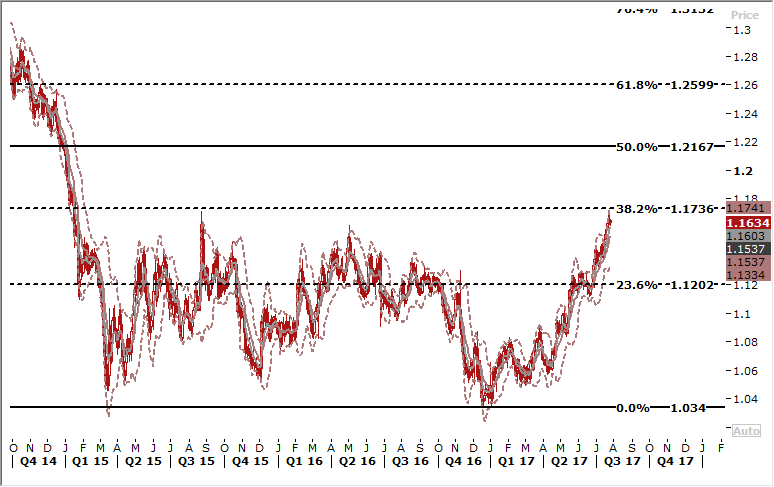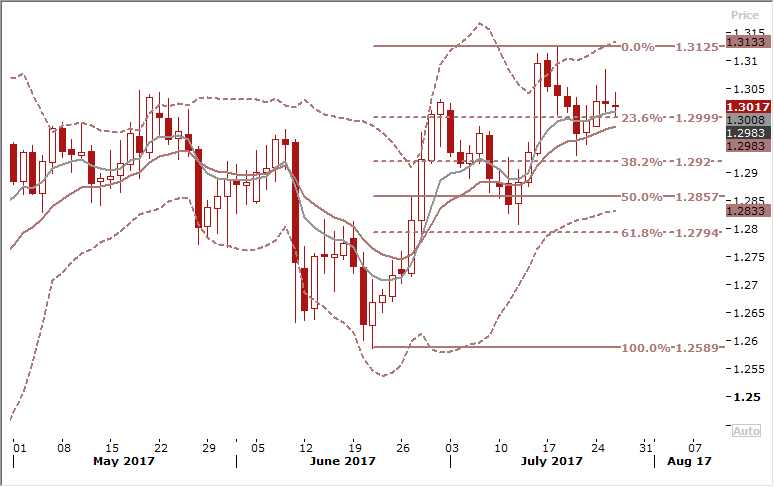EUR/USD: Will Fed trigger some profit taking today?
Macroeconomic overview: With no action expected on interest rates at the July FOMC meeting, Federal Reserve officials will continue to ponder the implementation of the balance-sheet runoff. Policy makers are broadly supportive of starting the reduction in 2017 so as to avoid leaving a major, unsettled policy question for Fed Chair Janet Yellen’s successor. In pursuing this non-economic motivation, Fed officials are aiming to divorce balance sheet operations from economic performance to the largest degree possible.
As a result, the Fed intends to shrink the balance-sheet passively in the background, leaving the central bank to actively calibrate the stance of monetary policy via the fed funds rate. If successful, it will shift market speculation on the Fed’s reaction function toward the fed funds rate (a well understood policy lever) and away from yields on longer-maturity assets.
Given the aforementioned “divorce,” policy makers are less inclined to delay the announcement of the start date for the balance-sheet unwind due to moderate economic underperformance, including the recent backsliding of inflation. We expect the unwind to commence in September (or October at latest). However, Fed officials’ desire to act in a well- telegraphed, non-disruptive fashion favors an earlier reveal, giving Treasury officials more time to plan issuance and market participants more time to prepare, as well.
Market participants place near zero probability on an interest-rate move at this meeting. According to the fed funds futures market, the next rate hike is not expected until either March or May of 2018, with little tightening priced-in thereafter. This stands in stark contrast with the Fed’s forecast for one additional hike before year-end and three more next year. We think that the next Fed funds rate increase will likely be in December.
The statement’s summation of overall economic activity will change little from that of the June meeting, thereby reiterating the transitory nature of first-quarter weakness. The previous characterizations of economic activity (“rising moderately”), job gains (“solid”), household spending (“has picked up”) and business fixed investment (“continued to expand”) all remain well-tailored to describe current conditions. As a result, the inherent signal is that policy makers are emphasizing their broader economic projections remain largely intact.
The official characterization of inflation is more vulnerable to change, given the ongoing deceleration in both the headline and core PCE deflators since the start of the year. Headline inflation, as measured by the PCE deflator, fell to 1.4% in May from 1.9% at the start of the year, while core inflation slipped to 1.4% from 1.8% over the same period. The committee already acknowledged the recent slowing in PCE-inflation measures in the June statement, but the trend has continued. As such, there may be some subtle language downgrades acknowledging a deeper and longer inflation soft patch in the near term; but officials will be sure to avoid any suggestion of eroding confidence in their ability to achieve the 2% objective in the medium term. The timeline may be extending modestly, but this will likely not be apparent until the September forecast update.
Technical analysis: Long shadow on Tuesday's candlestick could prove fatal for bulls ambition to reach the 1.1736 level - 38.2% fibo 1.3995-1.0340 fall. On balance, the overall bias remains on the upside, but the path ahead will likely be volatile and today’s Fed statement could trigger some profit taking. 
Short-term signal: We expect that today’s FOMC statement will trigger some profit taking on recent EUR/USD rally, but given recent bullish sentiment a short trade would be a risky position.
Long-term outlook: Bullish
GBP/USD: UK economy remains in notable slowdown
Macroeconomic overview: The U.K. economy’s lackluster performance extended into the second quarter, with growth only modestly picking up in the period. The expansion of 0.3%, in line with estimates, followed a 0.2% pace in the three months through March.
Publishing the figures on Wednesday, the Office for National Statistics said the economy experienced a “notable slowdown in the first half of this year.” Growth in the second quarter was led by services, which rose 0.5% and were the sole positive contributor.
Production and construction were a drag, and agriculture had zero impact. Within services, retail and the film industry, both production and cinema releases, were the main drivers. Even with the improvement in retailing in the second quarter, the sector posted flat growth over the six months through June. Consumers have struggled this year as faster inflation, reflecting the pound’s decline since the Brexit vote, puts a strain on their pockets.
The latest numbers reinforce the view that the strong performance by the economy immediately after the Brexit vote a year ago hasn’t been sustained into 2017. After a striking loss of momentum at the start of this year, the International Monetary Fund this week cut its 2017 growth forecast to 1.7% from 2%.
The second-quarter GDP reading compares with a 0.4% pace predicted by the Bank of England, where policy makers are divided on the outlook for the economy and how to respond. While a majority of BOE officials voted to keep interest rates at a record low last month, some pushed for an increase. They cited the pickup in inflation in the past year and said investment and trade would compensate for weaker consumption. The release is one of the last major economic data points for Governor Mark Carney and the Monetary Policy Committee to digest before their next policy announcement on August 3. Reports earlier this month showed inflation unexpectedly slowed in June and retail sales picked up.
The pound reversed an earlier advance against the dollar and gilts rose after data showed the U.K. economy extended its lackluster performance into the quarter through June.
We expect a 6-2 outcome for the meeting next week for the BOE to keep rates on hold.
Technical analysis: GBP/USD made recovery attempts from recent 1.2933 low posted last week, hitting 1.3084 Tuesday, but crucially failed to register a daily close above 1.3080 - 76.4% retrace of the 1.3126 to 1.2933 fall. The overwhelming risk remains on the downside. 
Short-term signal: There is a risk of deeper downward move below 1.3000, but we stay sideways.
Long-term outlook: Flat
AUD/USD falls on lower inflation and dovish Lowe
Macroeconomic overview: Australia’s inflation fell back below the central bank’s 2-3% target in the second quarter, easing market concerns that rate hikes were around the corner in 2018.
Inflation slowed to 1.9% year on year in the second quarter from 2.1% in the first quarter, in contrast with the consensus estimate of a pickup to 2.2%.
Tradables inflation, which fell by 0.9 ppt to 0.4% year on year, weighed on the headline measure. Fading base effects for fuel contributed to the slowdown. Non-tradables inflation continued to rise, reaching 2.7% compared with 2.6% in the first quarter and 1.6% a year earlier.
Inflation excluding volatile items like food and energy costs was 1.5% year on year in the second quarter, the same as in the first quarter and little changed from a year earlier. The RBA’s trimmed mean CPI was also stable at 1.8% year on year and little changed from a year earlier. While showing signs of stabilization, the trimmed mean CPI remains close to the 34-year low of 1.6% recorded in the fourth quarter 2016.
Looking ahead, inflation has scope to remain below or at the lower edge of the RBA’s target for some time. Nominal wage growth, 0.9% year on year in May and June, is the lowest since 2010 and forecast by the RBA to remain low "for a while yet." Household spending, which rose 2.3% year on year in the first quarter, remains weak relative to the 10-year trend of 2.7%. Investment, though improving, is still contracting. The rally in the prices of Australia’s commodity exports continues to fade.
Meanwhile, all of Australia’s growth engines - consumption, investment and exports - appear vulnerable to the tightening of monetary conditions by a growing number of major central banks. The Fed continues to signal further rate increases ahead and may start trimming its balance sheet before Chair Janet Yellen’s term ends in February 2018. Chinese President Xi Jinping’s focus remains on deleveraging to curb financial risks. The ECB is gearing up to signal tapering.
RBA Governor Philip Lowe said RBA does not need to move in lockstep as some central banks remove stimulus. He added that it would be better if currency was a bit lower.
The Australian dollar eased on the weaker-than-expected figures and comments from Lowe, as traders further pushed back already modest expectations of an interest rate rise.
Technical analysis: Long-term techs remain bullish. Monthly RSI is biased up with room to run and pair holds above the 23.6% fibo of 1.081-0.6827. Daily charts see long upper wicks on recent day candles. A near-term correction looks due. 
Short-term signal: We stay short at 0.7910.
Long-term outlook: Bullish
